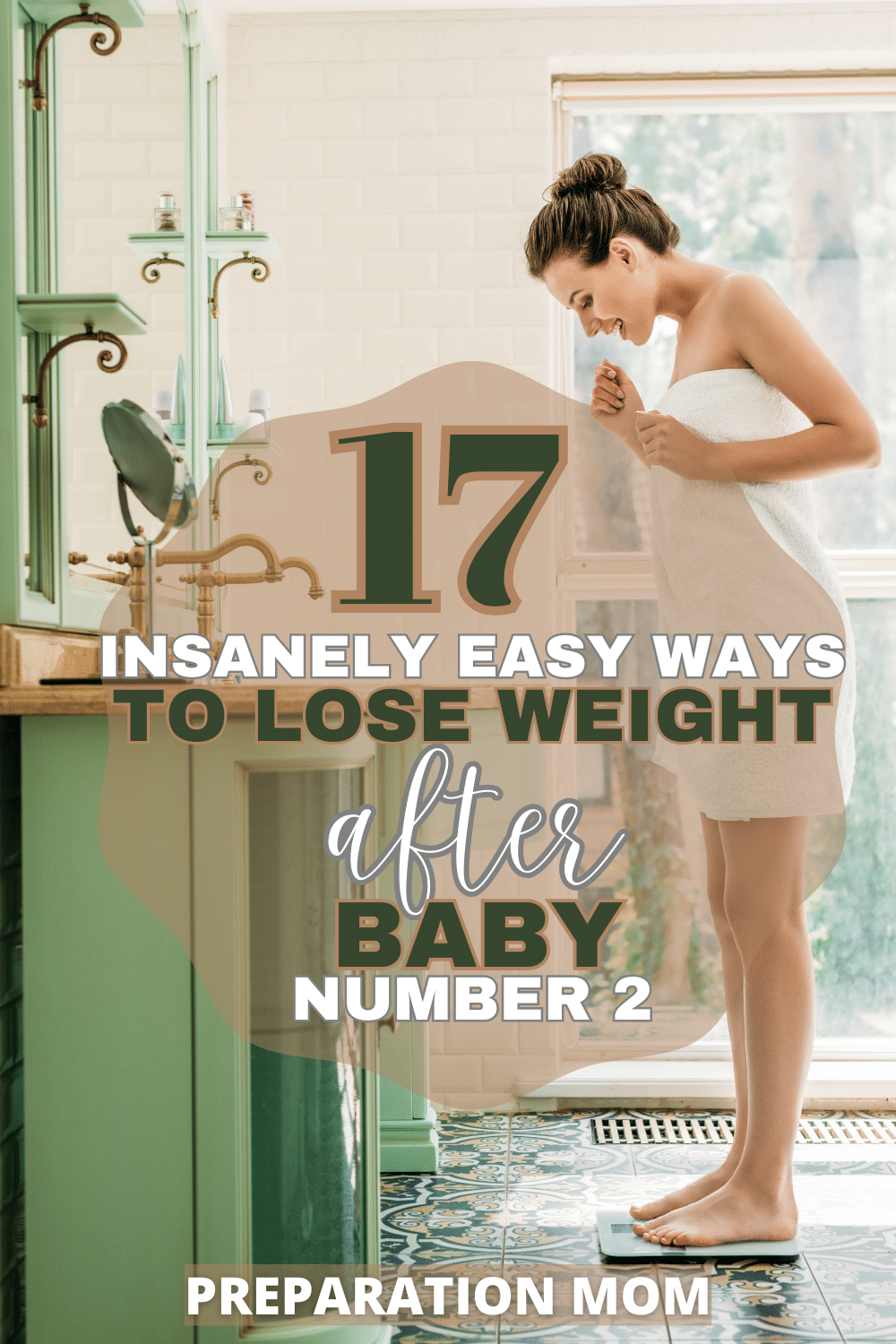Interested in losing weight after baby number 2? Try any combination of these 17 techniques to lose weight effortlessly.

Are you a mom of multiple babies, and eager to start losing weight after baby number 2?
When it comes to carrying, growing, and nurturing a tiny human being inside your body, you can be sure to grow some extra pounds while you’re at it.
One of the first recommendations a nurse provided me after finding out I was pregnant with my first child was to increase my calorie intake by at least 300 calories in the first trimester.
A pregnant woman is expected to gain about 25 pounds during pregnancy. In some cases (definitely in mine), a pregnant woman may gain a great deal more than just 25 pounds.
After you’ve given birth to your beautiful baby, you may find yourself with a strong desire to shed excess weight.
And if that’s the case, here are 17 ways to start losing weight after baby number 2.
I personally used a combination of all of these methods to successfully lose over 40 pounds after giving birth to my third child.
This post is all about losing weight after baby number 2.
This post may contain affiliate links, which means I’ll receive a commission if you purchase through my link, at no extra cost to you. Please read the full disclosure here.
Methods For Losing Weight After Baby Number 2:
1. Use a Compression Wrap while you wait until your 6-8 week postpartum period has passed
First and foremost, before you worry too much about weight loss, allow yourself some time for rest, relaxation, healing, and bonding with your new baby.
Without holding yourself to a strict diet, you can start integrating healthy foods into your meals. Some great options are spinach, oatmeal, and more water.
Each of these are also great if you’re breastfeeding because they will help boost your milk supply.
One easy tool to use in the early days after childbirth before delving into any focused diet and exercise routine is a compression wrap.
It will help reduce sagging and swelling of your abdomen and provide belly support to flatten your abdomen over time.
(You can use it well beyond 8 weeks after giving birth, FYI. I just recommend using it at the beginning instead of anything super rigorous right after giving birth).
2. Count Calories
I have found that one of the easiest ways to lose weight after pregnancy is calorie counting. It is recommended to stick to consuming about 1500 calories when you are attempting to lose weight.
It’s insanely easy to underestimate just how many calories are in the foods you are consuming.
Be mindful of the serving size on your food packages and the corresponding calories.
Then, keep a tally of your ingested number of calories. Stop when you’ve reached approximately 1500 for the day.
Eating higher fat content and lower carbs has made it so easy to stick to eating 1500 calories daily.
The increased fat intake keeps you feeling so much fuller than if you try to eat low-fat.
I can easily stick to my calorie goal without daydreaming about my next meal because I still feel hungry and dissatisfied.
For instance, I’ll eat two pieces of Babybel cheese with coffee and whipping cream for breakfast, then a ribeye steak with broccoli cooked in butter with salt and pepper for dinner, followed by my favorite sugar-free snack.
I feel so full and satisfied for the day while staying in line with my calorie goal for the day with no issues.
3. Measure Everything
You will want to measure all food, drinks (containing calories), and condiments to ensure you’re staying within your target calorie intake.
Follow the serving sizes and the number of calories each serving size contains and measure it precisely.
It is best to measure your food to make sure you’re calculating your calorie intake accurately.
(It’s so easy to underestimate just how much you’re consuming when you’re just eyeballing it and making approximations).
A digital scale is ideal for measuring ounces, milliliters, grams, etc.
Some packages of food tell you the number of calories that are in it per so many grams.
For example, I had a package of Brussel sprouts that was 25 calories in 85 grams.
Measuring in grams is also a more accurate measure than measuring by cups (¼ cup, ½ cup, etc.).
A digital scale will also be good for measuring drinks.
They can be measured by milliliters and fluid ounces.
For example, sometimes I would want a glass of soda, and I’d want to stay within my 1500 calories. 12 ounces of ginger ale totals 140 calories, and I could measure that I poured exactly 12 ounces on my scale.
Sometimes I might only have 6 ounces for a 70-calorie drink.
Digital scales are an essential tool for counting calories.
Measuring cups and measuring spoons are also useful, and, sometimes, more convenient (depending).

4. Keep a record of your food intake
When you’re tallying up your daily calories, it is most effective to write down what you’re eating, the amount of food you ate, and the corresponding number of calories it contained.
For example, if you have a serving of yogurt, you can record Yogurt – 6 oz. – 100 cal.
You can use an app or a good old fashioned pen and paper to keep track of what you’re eating.
Don’t forget to take anything into account.
I personally have done both, but the MyFitnessPal app makes the process SOO much easier and is my absolute favorite!
Get the MyFitnessPal App.

5. Intermittent Fast
Intermittent fasting is when you eat for a certain amount of hours throughout the day and then don’t eat for the remaining hours.
For example, you may eat from 12 pm to 8 pm.
You don’t eat anything again until 12 pm the following, then stop again at 8 pm. In this case, you eat for 8 hours of the day and fast for 16 hours of the day.
This technique in and of itself will automatically help you consume less.
Since you’re only eating within a small window of time throughout the day, you avoid eating ALL day aimlessly.
Eating all your calories within this timeframe will also help you feel fuller longer.
This makes it easier to adhere to this method.
(You feel fuller since you’re consuming all of your daily calories within just 8 hours instead of spread throughout a much longer day).
It also boosts energy levels since you’re not immediately shoving food in your mouth upon waking, which leads to sugar spikes and crashes that negatively impact your sugar levels.
These spikes and crashes make you feel sleepy, so avoiding them helps you preserve your energy.
Plus, in my experience, eating first thing leads to more desire for food, and eating for entertainment or boredom.
6. Consume at least one serving of fat per meal
Consuming a serving of fat is much more filling than trying to eat purely low-fat.
Being left with that feeling of hunger makes you think about nothing more than having your next meal.
Do so within reason and while keeping your calories in mind and keeping track of them.
If you’re making vegetables for dinner, you could add 1 tablespoon of butter and factor that into your daily intake.
Or maybe for lunch, cook your chicken in 1 tbsp of olive oil, which will be about 100 additional calories.
But definitely, the addition of fat in each meal will leave you feeling more satisfied and full.
7. Fill up on zero-calorie, unsweetened liquids
If you’re feeling hungry outside of your feeding window or wanting to eat just because, you may just be thirsty.
Even if that’s not the case, you can still fill up on sugar-free liquids.
You’ll want to consume liquids with no calories and no sugars, not even sugar substitutes, because they can spike cravings.
Instead of eating, make yourself a refreshing glass of water with lemon, unsweetened hot or iced tea (in any delicious flavor since they’re all 0 calories), or fresh hot or iced black coffee.
I used to love drinking cans of Arizona teas, but they’re loaded with sugar and calories.
Teavana afforded me the luxury of enjoying my tea without any sugar or calories.
The strawberry apple green tea flavor is my favorite!
8. Allow yourself a 1500 calorie cheat one day a week
Whatever you have a hankering for, go ahead and have at it as long as it’s within your 1500 calories.
So, that may be a cocktail, an appetizer, and a small dessert.
Then spend the rest of the day eating your typical 1500 calories as you would on any other day (for a total of 3000 calories for the day).
Even if you want something like a rich pasta from Olive Garden that’s over 1500 calories, get it. Just eat half or ¾ of it so it will fall in line with your 1500 calorie cheat.
My favorite cheat day is Saturday.
It’s my favorite day of the week since I can sleep in AND stay up late that day after a long work week.
It also feels like a bit of a reward after a focused week of calorie counting (Sunday-Friday) and exercise (Tuesday-Friday).
9. Plan Ahead
It’s much easier to stick to your daily calorie goal if you plan at least a day ahead.
Consider what sounds good for the 2-3 meals you want to eat within the 8 hours you’ll be eating.
Estimate the number of calories that’ll be in each meal so you know if a certain meal needs to be modified to avoid going over your daily food allowance.
10. Be Flexible
You’ll want to try to be consistent with your habits, but if you have a day where you need to eat an hour or two of outside of your feeding time, allow yourself to go with it.
Or if you happen to overeat by 300 calories, allow yourself that and just get more focused the next day.
Don’t beat yourself up, deprive yourself, or give up because you weren’t perfectly in line with your daily goal.
11. Exercise 4 days per week

Exercising 3 days per week is said to be a good starting number, and you can start that way if you want, then add on the fourth day after a couple of weeks or so to ease into it a bit, but I found 4 to be ideal.
Five days is only one day more but still feels much more demanding.
I found it best to stick with a Tuesday through Friday schedule with a 3 day weekend off from workouts.
12. Find a reliable buddy for your 4 days of workouts
It is so much easier to stay motivated and accountable to your exercise routine when you have a partner to exercise with who is as passionate about getting results and making exercise a regular part of their life as you.
You’ll also feel a little competitive with one another, which will push you further.
For instance, my big brother was my workout partner.
On cardio days, I would sometimes say, “Let’s do this machine for 20 minutes, then move on to the next.”
He would say, “Let’s go for at least a mile or 2 miles.”
This pushed us to further bounds since it’s possible to do 20 lackluster minutes of exercise or only go a quarter of a mile instead of a full mile.
13. Use HealthyWage
If you can’t find anyone with the time or energy to work out with you consistently, you can find motivation and competition by using HealthyWage.
With HealthyWage, you can set a goal weight loss amount and pitch in money with other individuals who have similar goals and possibly win all the money that the whole group contributed if you reach your goal first.
You can download their app on iOS or Android.
Get the HealthyWage App for Mac.
Get the HealthyWage App for Android.
14. Weigh yourself sporadically
Do not get on the scale frequently, hoping to drop all your weight all at once. It takes time.
I definitely wanted to check up on my progress, but I would only weigh myself once every 2 weeks or sometimes just once a month.
I didn’t want to risk getting discouraged or getting impatient with my results because I was constantly stalking the number on the scale.

15. Be consistent
Do it regularly, and don’t give up!
This is one of the most important keys to losing weight after baby number 2 – CONSISTENCY!
You have to take it one day at a time and focus on no more than that.
If it’s Tuesday, just count your 1500 calories and complete your workout.
Do the same for the rest of the week.
If Saturday is a rest day, take your rest and count your calories.
Don’t focus on anything more.
16. Don’t Overthink it!
Do not worry yourself sick about being perfect.
Don’t let your desire to lose weight consume your thoughts.
What I mean is don’t obsess about every morsel of food you put in your mouth or convince yourself that you must be doing something wrong if you haven’t dropped 20 pounds in a week.
Every time I’ve had massive success with weight loss, I didn’t stress about it or overthink it. I took it one day (and one meal) at a time.
If I had a slip-up, I didn’t sabotage the day or call it quits. I just treat the next meal like it’s a new day, and it’s time to stick to food goals again.
When I don’t overthink, I find it’s much easier to be mindful of my food intake with limited guilt about slip-ups.
The reduced feeling of guilt makes it easier for me to get back on track instead of just giving up (like extreme guilt makes me feel).
Not obsessing over perfection helps me spend less time obsessing over the scale as well.
This mindset leads me only to check the scale about once a month instead of daily or weekly.
I usually find myself feeling pleasantly surprised by the change I see in the number on the scale.
17. Be patient
The days are going to come to pass.
The time will go by, and the results will come to you; you just have to keep at it, again and again, day after day.
I highly recommend using all of these practices or at least selecting a few of these methods.
You can easily incorporate them into your daily lifestyle to help you shed those post-baby pounds.
This post was all about losing weight after baby number 2.
Other Posts You May Like:
- 7 Things to Put On Your Postpartum Care Plan To-Do List
- 14 Potty Training Essentials That’ll Help Your Toddler Use the Potty Like a Boss
- 6 Aids to Stop Your Toddler’s Thumbsucking Habit Dead in Its Tracks












Leave a Reply